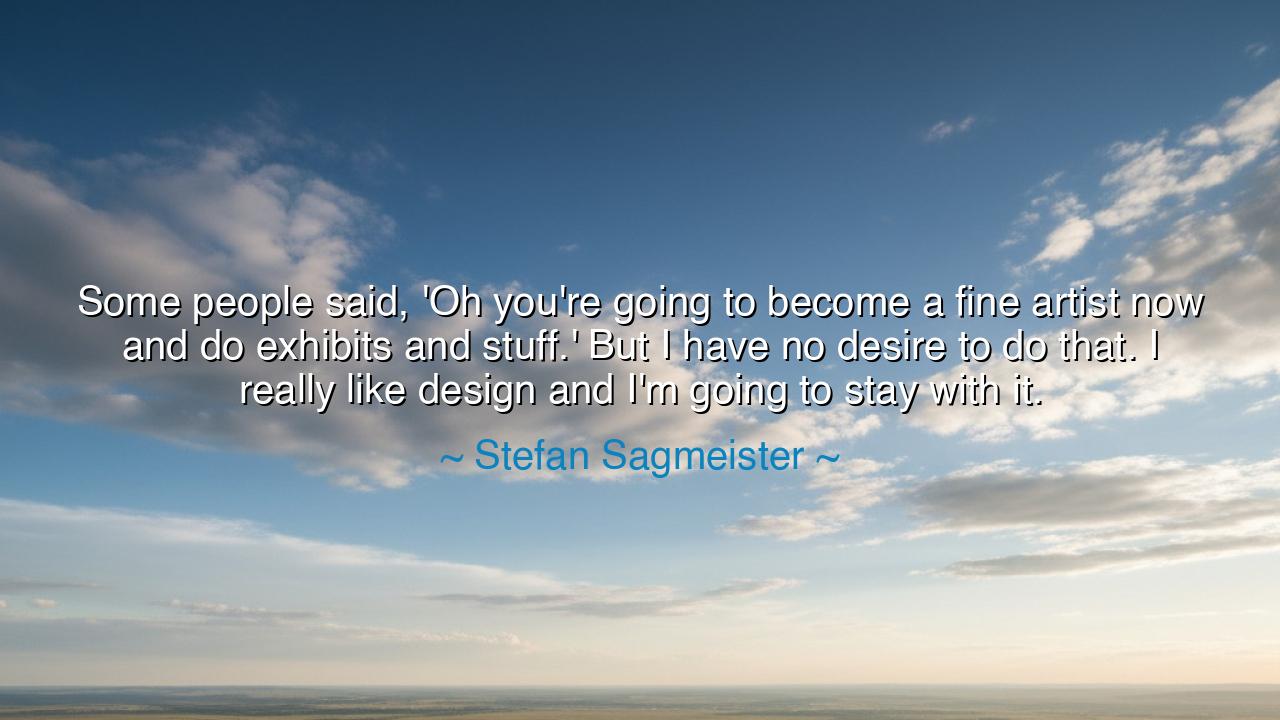
Some people said, 'Oh you're going to become a fine artist now
Some people said, 'Oh you're going to become a fine artist now and do exhibits and stuff.' But I have no desire to do that. I really like design and I'm going to stay with it.






The renowned designer Stefan Sagmeister once said: “Some people said, ‘Oh you’re going to become a fine artist now and do exhibits and stuff.’ But I have no desire to do that. I really like design and I’m going to stay with it.” At first, his words seem modest—a simple statement of preference. Yet beneath them flows a deep river of conviction, one that speaks to the eternal struggle between art and craft, between ambition and authenticity. Sagmeister’s declaration is not a rejection of art, but a defense of purpose—of remaining true to one’s chosen path even when the world tempts with prestige or status.
For centuries, the world has drawn a line between fine art and design, as though one were divine and the other merely functional. Art was said to dwell in museums, design in the marketplace. But Sagmeister, like the philosophers of old, knows that this division is an illusion. He sees design not as a lesser pursuit, but as a living dialogue between creativity and necessity, between imagination and service. To design is to shape life itself—to clothe ideas in form, to make the invisible visible. His refusal to abandon design for the so-called purity of art is an act of quiet rebellion against the hierarchy of the creative world.
In this, Sagmeister echoes the wisdom of the ancient artisans. The builders of the Parthenon, the weavers of Persian carpets, the calligraphers of the East—none sought fame in galleries. Their work was meant to serve: to elevate the spirit through usefulness, to harmonize beauty and function. And yet, centuries later, we revere their creations as art. The line between designer and artist has always been drawn not by the maker, but by the spectator. Sagmeister’s choice, therefore, is an act of humility and defiance—to remain faithful to the discipline that gives meaning to his creativity, rather than chase the hollow applause of artistic status.
His declaration also carries a spiritual tone, one that recalls the Stoic philosophers. Epictetus taught that each person has their place in the grand play of life, and the wise must perform their role with integrity, not envy another’s. Sagmeister has chosen his role—designer, communicator, builder of ideas—and he plays it fully, refusing the distraction of what others deem higher or nobler. In a time when many abandon their craft for titles, awards, or spectacle, his words are a hymn to the sacredness of staying true.
History gives us many such examples. The Renaissance sculptor Donatello refused to be lured by royal commissions that required him to abandon the intimate craft of bronze and marble. He preferred to work quietly in his workshop, for it was there, he said, that the divine spoke to his hands. Likewise, Sagmeister stays close to the tactile world of typography, posters, and visual storytelling—those humble forms that speak directly to human life. In doing so, he reminds us that greatness does not require ascension, but depth—to go deeper into one’s art, not higher above it.
The meaning of his words reaches beyond design. It is a call to every soul who feels the pull between passion and prestige, between the true path and the glittering one. It is easy to abandon the craft of love for the illusion of importance. But Sagmeister’s wisdom whispers that peace is found not in status, but in alignment—when one’s work reflects one’s spirit. To do what you love, and to stay with it through doubt and temptation, is a form of devotion.
So, let this be the teaching: Do not chase the world’s definitions of success. Stay faithful to your calling, however humble it seems. If your heart burns for design, or music, or teaching, let that be your cathedral. Others may call you artist or artisan—it matters not. What matters is that your work is honest, that it nourishes both you and those you serve. As Sagmeister shows us, true mastery lies not in ascending to new titles, but in inhabiting one’s craft so deeply that it becomes indistinguishable from one’s soul.
For in the end, the world’s praise fades like echoes in a vast hall, but the joy of purpose endures. To love your work and to stay with it—that is the purest art of all.






AAdministratorAdministrator
Welcome, honored guests. Please leave a comment, we will respond soon